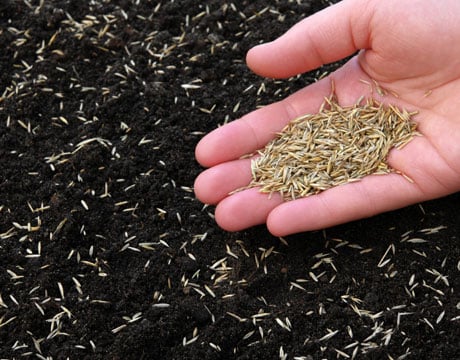

Spring is highly regarded as one of the best times to plant grass seed. Even the best maintained lawns usually have at least one area of concern that can use seeding in some way or another. Taking advantage of the optimal spring growing conditions make establishing seed for the average do-it-yourselfer much easier. By following a few easy steps and remembering a handful of helpful guidelines new grass will be growing in no time.
Seed Selection
Among many things, selecting the right type of seed is an essential step in the process of successfully establishing turf. It is very important to select a seed blend that will accommodate the growing conditions and environment it is planted in. Some grass species perform well in sun, but poorly in shade. To help make things easier, most seed manufactures label the seed bag for the condition the blend is recommended to grow best in. for example, a bag of seed might be labelled Sun Mixture, Sun/Shade Mixture, or Shade Mixture. Most mixtures contain several species of grass so they can accommodate multiple growing conditions. Kentucky Bluegrass and perennial Ryegrass perform best in full sun environments, while fine fescue can perform well in sun or shade conditions.Timing is Everything
The beginning of the spring growing season is an ideal time for seeding. Air and soil temperatures are warming up and natural rainfall is common making the establishment process that much more optimal. Seeding early also gives the grass plenty of time to fully establish before the summer months. Waitingtoo late after spring has passed makes it very challenging over the summer when heat and drought stress are overwhelming.
Water, Water, Water
The most important rule to follow when establishing grass seed is “If the seed dries, it dies.” Water is essential and without it the seed cannot germinate. Maintaining a light frequent watering schedule multiple times a day until the grass fully establishes is vital. This ensures the seed always stays moist and doesn’t dry out. Watering heavy for long periods of time poses a risk of washing the seed away before it can establish itself.Seed Germination
The speed at which seed germinates and establishes itself can be determined by several factors. Aside from weather conditions, grass species has the biggest influence. Each species germinates at a different speed, some quicker and some slower than others. Assuming optimal weather and growing conditions, some seed can germinate in as quickly as 4-7 days , or it can take as long as 21 days before germination begins. perennial Ryegrass is considered a quick germination grass species, while Kentucky Bluegrass is considered very slow.Establishment and Aftercare
Depending on the grass species, it can take several weeks and up to several months to fully establish new seedlings. As seedlings mature they develop their independent root system they require to grow healthy and withstand the natural stresses of its environment. Special aftercare is involved as it relates to mowing specifically. new seedlings are tender and can be easily damaged if mowing frequency and mowing height are not adjusted to favour the seedlings. Wait 4 – 6 weeks after full germination until regular mowing practices are adopted. Watering practices can also be adjusted to a deep and infrequent schedule providing the seedlings are not stressed. Balanced fertility is recommended to maintain and provide the essential plant nutrients the seedlings require to promote healthy establishment and growth.Seeding Options
Whether it’s seeding to fill in bare patches, repairing damaged areas, thickening up thin weak spots, or to establish a new lawn from bare soil, seeding is one of the most important things you can do for your lawn. Hand-spot seeding, broadcast overseeding, slitseeding, and complete lawn renovation seeding are several options to consider for different lawn conditions.Hand-spot seeding
A seeding option for very small areas generally no larger than the size of your fist can be effectively done with a hand-spot seeding method. This involves no equipment, just your hand to scoop seed out of a bag and sprinkle over these small areas. Best results can be achieved when the bare surface is scratched prior to seeding so the soil is broken up and seed to soil contact is optimal.Broadcast Overseeding
Broadcast overseeding is a great seeding option for lawns that are thin, weak and have minor areas of concern. overseeding introduces new grass seed that assists in thickening up these areas before they continue to get worse and other problems arise. overseeding is recommended for every lawn, even thebest conditioned lawns on an annual basis. Continually adding new grass to an old lawn helps keep it healthy and discourages weeds, insects and disease. Broadcast overseeding is commonly done using a manual push spreader the same or similar to the ones used for fertilizing. The seed is broadcast evenly across the lawn using this method. Drop spreaders can be used to accurately distribute seed around flower bed edges to ensure seed is not spread into these areas.
Slitseeding
Slitseeding is an aggressive seeding option that is used when a lawn is in very rough shape and a general broadcast overseeding will not be sufficient. Slitseeding is also commonly used to establish a new lawn from bare soil. A special machine slices rows into the soil and drops seed directly into the slits. This provides excellent seed to soil contact and optimizes germination and establishmentRelated Posts
Everything You Need To Know About Lawn Seed
What is growing on your lawn? If you answered with, “grass – duh!” – wrong answer. We're looking...
Everything You Need To Know About Ottawa Lawn Seed
What kind of grass is growing in your yard? It's a simple question, but just how many people...
Soil pH and Your Lawn: What You Need to Know
What is Soil pH?
Potential hydrogen, (better known as pH) is a measure of the acidity and...



